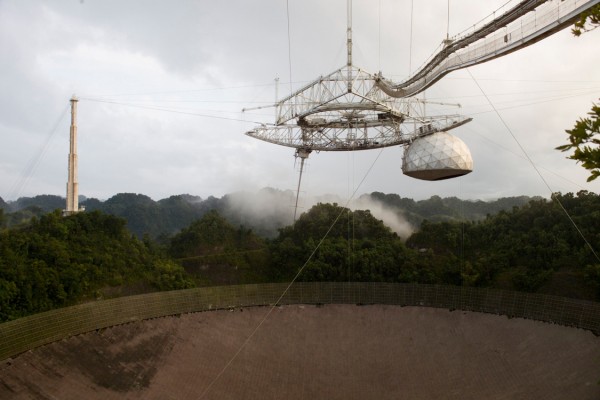By Ana Verayo, | March 05, 2016

The Arecibo telescope in Arecibo, Puerto Rico, which found repeating fast radio bursts, after astronomers reviewed PALFA (Pulsar Arecibo L-Band Feed Array) survey data.
For the first time ever, signals from distant galactic systems have been detected in repetitive patterns. These galactic signals travel for millions of light years from the outer edges of the universe where astronomers eagerly await for them, as they have been only picked up by powerful ground telescopes less than 20 times.
Like Us on Facebook
Formally known as Fast Radio Bursts, astronomers believe that these intergalactic signals are extremely rare. However, researchers from the Arecibo Radio Telescope in Puerto Rico observed an FRB that has been emitting bursts in repetition. This is also the first time that fast radio bursts have been observed in repeat patterns.
This repeating FRB signal was filtered through a deluge of Arecibo data in 2015, which has been consolidated from the world's largest radio telescope, surveying from 17 known sites of FRBs. Upon further analysis, one of these possible signals that have been combed through all these data known as FRB 121102, has been constantly repeating a signal. The latest FRB detection was announced just weeks in between the discovery of this repeating FRB signal.
Some scientists believe that the cosmic events that possibly caused these signals are galactic explosions however, this new analysis is suggesting another theory. According to Shami Chatterjee from Cornell University, in their new findings, FRBs are could not possibly originate from explosive events like colliding black holes or neutron stars, meaning, that this could have been a coincidence or there could be various types of FRBs.
FRBs mostly consist of powerful energy bursts that possesses a pulse for every 1/100 of a second, repeating thousands of times every day. Researchers say that if these events are occurring in a specific pattern, repeating itself, the FRB process would have not yet destroyed the core of the distant galaxy where the energy originates from.
It is still unclear what is the exact cause of these fast radio bursts, but scientists believe that these types of cosmic events are so powerful, with energies powerful enough to reach Earth from millions of light years away. Most astronomers however, believe that neutron stars in galactic cores exude these powerful energy bursts. These dying stars are so dense, that stellar material that can fit inside a thimble that can contain more mass than Mount Everest.
Prior to the discovery of this signal, all FRBs were detected by the CSIRO's Parkes Observatory in Australia, which is also a powerful telescope that can zoom in on a certain region in the sky at a single time, the Arecibo on the other hand is designed for more intensive analysis.
This new study is published in the journal, Nature.
-
Use of Coronavirus Pandemic Drones Raises Privacy Concerns: Drones Spread Fear, Local Officials Say

-
Coronavirus Hampers The Delivery Of Lockheed Martin F-35 Stealth Fighters For 2020

-
Instagram Speeds Up Plans to Add Account Memorialization Feature Due to COVID-19 Deaths

-
NASA: Perseverance Plans to Bring 'Mars Rock' to Earth in 2031

-
600 Dead And 3,000 In The Hospital as Iranians Believed Drinking High-Concentrations of Alcohol Can Cure The Coronavirus

-
600 Dead And 3,000 In The Hospital as Iranians Believed Drinking High-Concentrations of Alcohol Can Cure The Coronavirus

-
COVID-19: Doctors, Nurses Use Virtual Reality to Learn New Skills in Treating Coronavirus Patients







